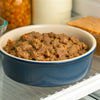Can Dogs Eat Just Wet Food? A Comprehensive Guide to Feeding Your Furry Friend
- Houndsy
Table of Contents
- Introduction
- Understanding Wet Dog Food
- Advantages of Feeding Wet Food
- Considerations and Potential Drawbacks
- Transitioning to Wet Food
- Mixing Wet and Dry Food: A Balanced Approach
- FAQs About Wet Dog Food
- Conclusion
Introduction
Have you ever found yourself sneaking a taste of your dog’s dinner or wondering why they seem to prefer that luscious wet food over their kibble? If so, you’re not alone! Recent studies indicate that nearly 75% of pet owners consider their dog's eating habits a key part of their dietary routine. With the rise of wet dog food options in the market, many of us find ourselves asking, can dogs eat just wet food? This question is far more complex than it may seem, delving into a realm of choice related to nutrition, health, and individual dog preferences.
As devoted pet lovers, we want to ensure that our four-legged companions receive the best possible nutrition. This blog aims to clarify the implications of exclusively feeding wet food to dogs and help you make informed feeding choices that contribute to your pup's happiness and health. We’ll explore the nutritional profiles of wet versus dry food, the benefits and potential drawbacks, and practical tips for integrating wet food into your dog's diet.
By the end of this post, you will have a solid understanding of whether a wet food-only diet is suitable for your furry friend and how to implement it if desired. Let’s embark on this exciting journey of pet nutrition together and make feeding time a joyful experience for both you and your dog!
Understanding Wet Dog Food
What is Wet Dog Food?
Wet dog food, also known as canned dog food, typically contains about 75-80% moisture, making it a highly palatable alternative to dry kibble. It's designed to be tasty while offering various nutrients that meet a dog's dietary needs. The appealing aroma and texture can entice even the pickiest eaters, making wet food an excellent choice for diverse canine palates.
Nutritional Value of Wet Food
When selecting wet food, it's essential to ensure it’s nutritionally balanced. A high-quality wet dog food will include:
- Animal protein: The primary ingredient should specify a named protein source like chicken, beef, or fish.
- Healthy fats: Essential fatty acids that contribute to coat and skin health.
- Vitamins and minerals: Essential nutrients that support your dog’s overall health.
- Hydration: The high moisture content helps dogs stay hydrated, especially important for those who may not drink enough water.
Common Misconceptions About Wet Food
There are numerous myths surrounding wet dog food that might make pet parents hesitant to consider a wet food-only diet. Here are a few common misconceptions:
- Wet food leads to weight gain: This is a myth! In fact, wet food often contains lower carbohydrates and can help with weight management.
- It's less nutritious than dry food: Quality wet dog foods are engineered to be just as nutritious as their dry counterparts.
- Wet food is only for sick dogs or puppies: While it’s great for those groups, any dog can enjoy wet food as a nutritious option!
Advantages of Feeding Wet Food
Feeding your dog wet food can provide several benefits that cater to specific needs. Let's break down the key advantages:
Enhanced Palatability
Dogs are often attracted to the rich flavor and aroma of wet food. Its texture can be much more appetizing, especially for finicky eaters. This quality makes wet food an excellent option for dogs that may struggle with appetite, whether due to age, health issues, or just being picky.
Increased Hydration
The moisture content in wet dog food is a significant advantage, particularly for dogs who may not drink enough water. Staying well-hydrated is crucial for kidney health, digestion, and overall bodily function. For older dogs or those with certain medical conditions, wet food can be a wonderful way to boost hydration.
Easier Chewing
For puppies, senior dogs, or those with dental issues, wet food is tender and easy to chew. While dry kibble has its dental benefits, the softness of wet food allows dogs to enjoy their meals without discomfort.
Nutrient Density
Wet food typically contains higher protein content and fewer carbohydrates compared to dry kibble. This can be particularly advantageous for dogs that require more protein for energy. Additionally, if your dog has specific dietary restrictions, many high-quality wet foods provide options tailored to their needs.
Considerations and Potential Drawbacks
Despite the numerous benefits, there are also considerations to keep in mind when deciding whether a wet food-only diet is appropriate for your dog.
Cost Constraints
Wet food tends to be more expensive than dry food. For pet owners with larger dogs or multiple pets, the cost of feeding solely wet food can add up significantly. Balancing wet and dry options might be a more economical solution.
Storage and Shelf Life
Wet food should be stored properly once opened, requiring refrigeration and consumption within several days. This is unlike dry food, which can often sit out longer without spoilage. For busy pet parents, this can introduce some inconveniences.
Dental Health Concerns
One common argument against wet food is its effect on dental health. While it may not clean teeth like dry kibble can, regular dental care—such as brushing, dental chews, and veterinary check-ups—can help mitigate these risks.
Mess and Cleanup
Wet food can be messier than dry food, with the potential for smelly leftovers in your dog's bowl. A feeding mat can help manage this and keep your area cleaner.
Transitioning to Wet Food
If you're considering a transition from dry kibble to wet food, it's essential to do so gradually. Sudden changes can upset your dog's stomach and lead to digestive issues. Here’s a step-by-step approach:
- Start Slow: Introduce wet food mixed with your dog’s usual kibble. Gradually increase the wet food ratio over a week, observing any changes in appetite or digestive response.
- Monitor Health: Watch for any adverse reactions, such as diarrhea or decreased appetite.
- Consult Your Veterinarian: Regular consultations with your vet can help you tailor your dog's diet to their specific needs and health requirements.
Mixing Wet and Dry Food: A Balanced Approach
For many dog owners, a mixed diet of wet and dry food proves to be the most practical solution. This approach combines the sensory benefits of wet food with the conveniences of kibble. Let’s explore some reasons this combination can work beautifully:
Variety of Textures and Flavors
By mixing wet and dry food, you expose your dog to a range of flavors and textures, which can keep meal times interesting. This variety can stimulate their appetite and maintain enthusiasm for their meals.
Nutritional Balance
Combining wet and dry food can enhance overall nutrition and bolster hydration. While wet food is great for hydration, dry kibble can help with dental health. It’s a win-win!
Cost Efficiency
Using wet food as a topper for dry kibble can reduce the overall expense associated with feeding solely on wet food while still providing a delectable meal for your pup.
FAQs About Wet Dog Food
Can dogs eat just wet food?
Absolutely! Dogs can thrive on a wet food-only diet if it meets their nutritional needs and is of high quality. Always consult with your veterinarian to ensure you’re providing a balanced diet.
Is wet food better for puppies and senior dogs?
Yes, wet food is often easier for puppies and senior dogs to chew and digest. It can offer comfort and nutrition for these vulnerable age groups.
Does wet food make dogs gain weight?
Not inherently. The composition of the diet matters. High-quality wet food can help maintain a healthy weight, whereas low-quality brands might contain fillers that can contribute to weight gain.
Are there any long-term effects of feeding wet food only?
If the wet food is well-balanced and nutritionally complete, there should not be negative long-term effects. Always monitor your dog’s health and performance.
How should wet food be stored?
Once opened, wet food should be refrigerated and used within 5-7 days. Make sure to seal it well to maintain freshness.
Conclusion
Feeding wet food exclusively to our furry friends can be a wise choice—a decision that caters to their palatability preferences, hydration needs, and nutritional health. While there are considerations to keep in mind, such as cost and dental health, the benefits often outweigh the drawbacks.
As dog lovers, our goal is to enrich our pet's lives while ensuring they're receiving their required nutrition. We at Houndsy believe that every mealtime should enhance the experience for both pets and their owners. If you’re seeking innovative solutions to simplify the feeding experience, explore our Houndsy Kibble Dispenser to complement your pet’s diet, whether you go with wet, dry, or a mix! Elevate your feeding routine, adding convenience and style to the experience.
Embrace your dog’s unique culinary journey, consult your vet as needed, and thank you for caring deeply about your pet's diet! Happy feeding!












